Deck 8: Cell Signaling Systems
Question
Question
Question
Question
Question
Question
Question
Question
Question
Question
Question
Question
Question
Question
Question
Question
Question
Question
Question
Question
Question
Question
Question
Question
Question
Question
Question
Question
Question
Question
Question
Question
Question
Question
Question
Question
Question
Question
Question
Question
Question
Question
Question
Question
Question
Question
Question
Question
Question
Question
Question
Question
Question
Question
Question
Question
Question
Question
Question
Question
Question
Question
Question
Question
Question
Question
Question
Question
Question
Question
Question
Question
Question
Question
Question
Question
Question
Question
Question
Question

Unlock Deck
Sign up to unlock the cards in this deck!
Unlock Deck
Unlock Deck
1/102
Play
Full screen (f)
Deck 8: Cell Signaling Systems
1
Which class of proteins interacts with a heterotrimeric intracellular protein?
A) receptor tyrosine kinases
B) TNF receptor family
C) G protein-coupled receptors
D) nuclear transmembrane proteins
A) receptor tyrosine kinases
B) TNF receptor family
C) G protein-coupled receptors
D) nuclear transmembrane proteins
G protein-coupled receptors
2
Estradiol is secreted by the ovaries, travels through the bloodstream, and interacts with estrogen receptors on breast epithelial cells. In this scenario estradiol is acting through which type of mechanism?
A) synacrine
B) paracrine
C) endocrine
D) autocrine
A) synacrine
B) paracrine
C) endocrine
D) autocrine
endocrine
3
Ligand binding causes which of the following to form trimers?
A) tumor necrosis factor receptors
B) receptor tyrosine kinases
C) G protein-couplesd receptors
D) nicotinic acetylcholine receptors
A) tumor necrosis factor receptors
B) receptor tyrosine kinases
C) G protein-couplesd receptors
D) nicotinic acetylcholine receptors
tumor necrosis factor receptors
4
A Western blot analysis of the expression of estrogen receptors in ovarian tissues at different times of the estrous cycle showed approximately four times greater protein levels at day 2 compared with day 10 of the cycle. Which of the following may be true given these data?
A) Estrogen is acting as an endocrine signal in the ovaries.
B) Estrogen is acting as an autocrine signal in the ovaries.
C) Ovaries only secrete estrogen early in the estrous cycle.
D) Ovarian tissue is responsive to estrogen only early in the estrous cycle.
A) Estrogen is acting as an endocrine signal in the ovaries.
B) Estrogen is acting as an autocrine signal in the ovaries.
C) Ovaries only secrete estrogen early in the estrous cycle.
D) Ovarian tissue is responsive to estrogen only early in the estrous cycle.

Unlock Deck
Unlock for access to all 102 flashcards in this deck.
Unlock Deck
k this deck
5
Levels of diacylglycerol increase in a cell on binding of a ligand to a taste receptor. Which trimeric G protein subunit is most likely to be bound to GTP?
A) Gq
B) Gt
C) G
D) Gi
A) Gq
B) Gt
C) G
D) Gi

Unlock Deck
Unlock for access to all 102 flashcards in this deck.
Unlock Deck
k this deck
6
Muscle relaxation in response to nitric oxide would be reduced if a(n) was present.
A) stimulator of cGMP phosphodiesterase
B) inhibitor of protein kinase A
C) inhibitor of acetylcholine esterase
D) stimulator of guanylate cyclase
A) stimulator of cGMP phosphodiesterase
B) inhibitor of protein kinase A
C) inhibitor of acetylcholine esterase
D) stimulator of guanylate cyclase

Unlock Deck
Unlock for access to all 102 flashcards in this deck.
Unlock Deck
k this deck
7
Cyclic GMP is the during vasodilation.
A) first messenger
B) second messenger
C) paracrine signal
D) activator of nitric oxide synthetase
A) first messenger
B) second messenger
C) paracrine signal
D) activator of nitric oxide synthetase

Unlock Deck
Unlock for access to all 102 flashcards in this deck.
Unlock Deck
k this deck
8
Acetylcholine is a neurotransmitter that stimulates muscle contraction. Acetylcholine is acting as a(n)
A) endocrine signal.
B) paracrine signal.
C) autocrine signal.
D) second messenger.
A) endocrine signal.
B) paracrine signal.
C) autocrine signal.
D) second messenger.

Unlock Deck
Unlock for access to all 102 flashcards in this deck.
Unlock Deck
k this deck
9
Which of the following is an example of a first or second messenger?
A) peptide hormone
B) G protein-coupled receptor
C) protein kinase
D) cyclic nucleotide phosphodiesterase
A) peptide hormone
B) G protein-coupled receptor
C) protein kinase
D) cyclic nucleotide phosphodiesterase

Unlock Deck
Unlock for access to all 102 flashcards in this deck.
Unlock Deck
k this deck
10
Construct a functional signal transduction pathway by placing the following actors in the correct order:
A. upstream signaling protein
B. second messenger
C. receptor protein
D. first messenger
E. target proteins
F. downstream signaling protein
A) D, E, C, A, B, F
B) C, D, A, B, F, E
C) D, C, A, B, F, E
D) D, C, B, A, F, E
A. upstream signaling protein
B. second messenger
C. receptor protein
D. first messenger
E. target proteins
F. downstream signaling protein
A) D, E, C, A, B, F
B) C, D, A, B, F, E
C) D, C, A, B, F, E
D) D, C, B, A, F, E

Unlock Deck
Unlock for access to all 102 flashcards in this deck.
Unlock Deck
k this deck
11
Which of the following is activated or increased in a liver cell on exposure to either glucagon or epinephrine?
A) GTPq
B) phospholipase C
C) cAMP
D) DAG
A) GTPq
B) phospholipase C
C) cAMP
D) DAG

Unlock Deck
Unlock for access to all 102 flashcards in this deck.
Unlock Deck
k this deck
12
Which of the following is a GTPase?
A) G
B) G
C) Gs
D) G
A) G
B) G
C) Gs
D) G

Unlock Deck
Unlock for access to all 102 flashcards in this deck.
Unlock Deck
k this deck
13
Which of the following does NOT participate in a signal transduction pathway?
A) second messenger
B) first messenger
C) receptor protein
D) lipid transporter
A) second messenger
B) first messenger
C) receptor protein
D) lipid transporter

Unlock Deck
Unlock for access to all 102 flashcards in this deck.
Unlock Deck
k this deck
14
An estrogen-dependent breast cancer cell line is grown in a medium that contains estrogen. Cell proliferation is monitored over time. In a separate experiment, the cell line is grown in a medium that lacks estrogen but includes bisphenol A, a compound found in polycarbonate plastics. When monitored, cell proliferation is higher than in the presence of estrogen. A possible explanation of these results is that bisphenol A
A) inhibits the binding of estrogen to the estrogen receptor.
B) is an agonist of the estrogen receptor.
C) inhibits adenylate cyclase.
D) is toxic to the cell line.
A) inhibits the binding of estrogen to the estrogen receptor.
B) is an agonist of the estrogen receptor.
C) inhibits adenylate cyclase.
D) is toxic to the cell line.

Unlock Deck
Unlock for access to all 102 flashcards in this deck.
Unlock Deck
k this deck
15
The levels of the second messenger involved in vasodilation are increased by and decreased by _.
A) cGMP cyclase; guanylate phosphodiesterase
B) guanylate phosphodiesterase; cGMP cyclase
C) guanylate cyclase; cGMP phosphodiesterase
D) cGMP phosphodiesterase; guanylate cyclase
A) cGMP cyclase; guanylate phosphodiesterase
B) guanylate phosphodiesterase; cGMP cyclase
C) guanylate cyclase; cGMP phosphodiesterase
D) cGMP phosphodiesterase; guanylate cyclase

Unlock Deck
Unlock for access to all 102 flashcards in this deck.
Unlock Deck
k this deck
16
A ligand binds to a transmembrane protein. This causes a conformational change in the protein that is detected by an intracellular protein. The intracellular protein is an enzyme that adds phosphate groups to target proteins. The phosphorylated proteins cause a physiological change within the cell. This is an example of
A) a metabolic pathway.
B) homeostasis.
C) a signal transduction pathway.
D) an allosteric inhibition pathway.
A) a metabolic pathway.
B) homeostasis.
C) a signal transduction pathway.
D) an allosteric inhibition pathway.

Unlock Deck
Unlock for access to all 102 flashcards in this deck.
Unlock Deck
k this deck
17
First messengers, but NOT second messengers
A) bind to a protein.
B) act as a transcription factor.
C) are located extracellularly.
D) are an allosteric effector.
A) bind to a protein.
B) act as a transcription factor.
C) are located extracellularly.
D) are an allosteric effector.

Unlock Deck
Unlock for access to all 102 flashcards in this deck.
Unlock Deck
k this deck
18
The subunit of trimeric G proteins can function to
A) regulate ion channels.
B) activate adenylate cyclase.
C) inhibit phospholipase A.
D) inhibit phosphodiesterase.
A) regulate ion channels.
B) activate adenylate cyclase.
C) inhibit phospholipase A.
D) inhibit phosphodiesterase.

Unlock Deck
Unlock for access to all 102 flashcards in this deck.
Unlock Deck
k this deck
19
Which of the following list includes ONLY first messengers?
A) cortisol, insulin, prostaglandins
B) nitric oxide, estradiol, heme
C) insulin, glucagon, glucose
D) Ca2+, testosterone, protein kinase A
A) cortisol, insulin, prostaglandins
B) nitric oxide, estradiol, heme
C) insulin, glucagon, glucose
D) Ca2+, testosterone, protein kinase A

Unlock Deck
Unlock for access to all 102 flashcards in this deck.
Unlock Deck
k this deck
20
What characteristic is true for both RTKs and GPCRs?
A) The receptor binds to intracellular proteins only when activated.
B) When activated, the receptor has enzymatic activity.
C) The receptor transmits ions.
D) The receptor undergoes a conformational change on activation.
A) The receptor binds to intracellular proteins only when activated.
B) When activated, the receptor has enzymatic activity.
C) The receptor transmits ions.
D) The receptor undergoes a conformational change on activation.

Unlock Deck
Unlock for access to all 102 flashcards in this deck.
Unlock Deck
k this deck
21
When PKA is inactive, which of the following is true?
A) The pseudosubstrate of the PKA regulatory subunits is bound in the active site of the catalytic subunits.
B) The regulatory subunits are bound by cAMP.
C) The regulatory subunits are bound by GTP.
D) ATP is unable to bind the catalytic subunits.
A) The pseudosubstrate of the PKA regulatory subunits is bound in the active site of the catalytic subunits.
B) The regulatory subunits are bound by cAMP.
C) The regulatory subunits are bound by GTP.
D) ATP is unable to bind the catalytic subunits.

Unlock Deck
Unlock for access to all 102 flashcards in this deck.
Unlock Deck
k this deck
22
When bound to GTP, GS obtains a conformation that promotes interaction with
A) adenylate cyclase.
B) PKA.
C) the G protein-coupled receptor.
D) phospholipase C.
A) adenylate cyclase.
B) PKA.
C) the G protein-coupled receptor.
D) phospholipase C.

Unlock Deck
Unlock for access to all 102 flashcards in this deck.
Unlock Deck
k this deck
23
Below is shown a short sequence of a protein. Which of the following domains would most likely bind this sequence? 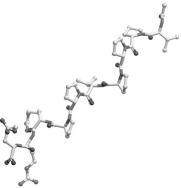
A) SH2
B) SH3
C) SH2a
D) SHP

A) SH2
B) SH3
C) SH2a
D) SHP

Unlock Deck
Unlock for access to all 102 flashcards in this deck.
Unlock Deck
k this deck
24
If there were a technique that allowed one to isolate EGFR1 and EGFR2 at discrete steps along their activation pathway, which of the following would be isolated?
A) A dimer in which EGFR2 contains phosphotyrosines but EGFR1 does not.
B) A dimer in which EGFR1 contains phosphotyrosines but EGFR2 does not.
C) A monomer of EGFR1 that contains phosphotyrosines.
D) A monomer of EGFR2 that contains phosphotyrosines.
A) A dimer in which EGFR2 contains phosphotyrosines but EGFR1 does not.
B) A dimer in which EGFR1 contains phosphotyrosines but EGFR2 does not.
C) A monomer of EGFR1 that contains phosphotyrosines.
D) A monomer of EGFR2 that contains phosphotyrosines.

Unlock Deck
Unlock for access to all 102 flashcards in this deck.
Unlock Deck
k this deck
25
Which of the following is true of a recessive oncogene mutation but NOT a dominant oncogene mutation?
A) It results in a disease phenotype any time the mutation is present in a cell.
B) It results in a disease phenotype only when both copies of the mutated oncogene are present in the same cell.
C) It is a gain-of-function mutation.
D) It is a mutation in a tumor suppressor gene.
A) It results in a disease phenotype any time the mutation is present in a cell.
B) It results in a disease phenotype only when both copies of the mutated oncogene are present in the same cell.
C) It is a gain-of-function mutation.
D) It is a mutation in a tumor suppressor gene.

Unlock Deck
Unlock for access to all 102 flashcards in this deck.
Unlock Deck
k this deck
26
On binding of an insulin molecule to the insulin receptor, a conformational change occurs that
A) increases the affinity of a second insulin binding site.
B) causes the dimerization of the receptor.
C) brings the L1 region of the subunit closer to the membrane.
D) stimulates tyrosine autophosphorylation in the subunits.
A) increases the affinity of a second insulin binding site.
B) causes the dimerization of the receptor.
C) brings the L1 region of the subunit closer to the membrane.
D) stimulates tyrosine autophosphorylation in the subunits.

Unlock Deck
Unlock for access to all 102 flashcards in this deck.
Unlock Deck
k this deck
27
Place the following steps in proper order:
A. phosphorylation of RTK cytoplasmic tails
B. activation of downstream signaling pathways
C. ligand binding, receptor dimerization, and kinase activation
D. protein binding to RTK phosphotyrosines and phosphorylation of target proteins
A) C, D, A, B
B) C, B, A, D
C) C, A, D, B
D) B, C, A, D
A. phosphorylation of RTK cytoplasmic tails
B. activation of downstream signaling pathways
C. ligand binding, receptor dimerization, and kinase activation
D. protein binding to RTK phosphotyrosines and phosphorylation of target proteins
A) C, D, A, B
B) C, B, A, D
C) C, A, D, B
D) B, C, A, D

Unlock Deck
Unlock for access to all 102 flashcards in this deck.
Unlock Deck
k this deck
28
The insulin receptor is a type of
A) G protein-linked receptor.
B) receptor tyrosine kinase.
C) oncogene.
D) MEK.
A) G protein-linked receptor.
B) receptor tyrosine kinase.
C) oncogene.
D) MEK.

Unlock Deck
Unlock for access to all 102 flashcards in this deck.
Unlock Deck
k this deck
29
Which of the following prevents GPCR from reassociating with the G complex?
A) " -arrestin"
B) "GTPase activating protein"
C) "cAMP phosphodiesterase"
D) "RGS"
A) " -arrestin"
B) "GTPase activating protein"
C) "cAMP phosphodiesterase"
D) "RGS"

Unlock Deck
Unlock for access to all 102 flashcards in this deck.
Unlock Deck
k this deck
30
The __________ is a specific type of _.
A) "GRK; ARK"
B) " -adrenergic receptor kinase; -arrestin"
C) "regulator of G protein signaling; GTPase activating protein"
D) "GTPase activating protein; guanine nucleotide exchange factor"
A) "GRK; ARK"
B) " -adrenergic receptor kinase; -arrestin"
C) "regulator of G protein signaling; GTPase activating protein"
D) "GTPase activating protein; guanine nucleotide exchange factor"

Unlock Deck
Unlock for access to all 102 flashcards in this deck.
Unlock Deck
k this deck
31
Which scenario would allow -arrestin to bind to the GPCR?
A) " ARK is internalized into the endosome."
B) "The receptor is phosphorylated."
C) "G is bound to GDP."
D) "The regulatory subunit of -arrestin is removed."
A) " ARK is internalized into the endosome."
B) "The receptor is phosphorylated."
C) "G is bound to GDP."
D) "The regulatory subunit of -arrestin is removed."

Unlock Deck
Unlock for access to all 102 flashcards in this deck.
Unlock Deck
k this deck
32
Which of the following compounds is a pharmaceutical adrenergic receptor agonist?
A) dopamine
B) metoprolol
C) norepinephrine
D) clonidine
A) dopamine
B) metoprolol
C) norepinephrine
D) clonidine

Unlock Deck
Unlock for access to all 102 flashcards in this deck.
Unlock Deck
k this deck
33
If GRB2 were truncated so that the N-terminal domain was missing, the truncated protein would be unable to bind the
A) phosphorylated Tyr of the SOS protein.
B) phosphorylated Tyr of the RTK substrate.
C) proline-rich sequence of the SOS protein.
D) protein-rich sequence of the RTK substrate.
A) phosphorylated Tyr of the SOS protein.
B) phosphorylated Tyr of the RTK substrate.
C) proline-rich sequence of the SOS protein.
D) protein-rich sequence of the RTK substrate.

Unlock Deck
Unlock for access to all 102 flashcards in this deck.
Unlock Deck
k this deck
34
A mutation causes a cell to divide uncontrollably. Analysis of the cell shows that both copies of the gene must have the mutation. From this information, it can be determined that the mutation is
A) dominant.
B) recessive.
C) in a gene coding a kinase.
D) in a tumor suppressor gene.
A) dominant.
B) recessive.
C) in a gene coding a kinase.
D) in a tumor suppressor gene.

Unlock Deck
Unlock for access to all 102 flashcards in this deck.
Unlock Deck
k this deck
35
Below is a schematic representation of a dimerized receptor tyrosine kinase. Where is the kinase function located? 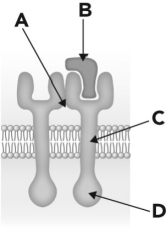
A) A
B) B
C) C
D) D

A) A
B) B
C) C
D) D

Unlock Deck
Unlock for access to all 102 flashcards in this deck.
Unlock Deck
k this deck
36
Liver cells were monitored for changes in metabolic enzymatic activity after exposure to glucagon. The enzymes that showed changes in activity were then analyzed to assess if they had been covalently modified. Which of the following results were likely observed?
A) Enzymes that showed lower activity were not phosphorylated.
B) Enzymes that showed higher activity were methylated.
C) Enzymes that showed altered activity (higher or lower) were phosphorylated.
D) Enzymes that showed altered activity (higher or lower) were methylated.
A) Enzymes that showed lower activity were not phosphorylated.
B) Enzymes that showed higher activity were methylated.
C) Enzymes that showed altered activity (higher or lower) were phosphorylated.
D) Enzymes that showed altered activity (higher or lower) were methylated.

Unlock Deck
Unlock for access to all 102 flashcards in this deck.
Unlock Deck
k this deck
37
When the regulatory subunit of PKA is bound to cAMP,
A) it dissociates into monomers.
B) the pseudosubstrate is phosphorylated.
C) it cannot bind to catalytic subunit of PKA.
D) it is part of a tetramer.
A) it dissociates into monomers.
B) the pseudosubstrate is phosphorylated.
C) it cannot bind to catalytic subunit of PKA.
D) it is part of a tetramer.

Unlock Deck
Unlock for access to all 102 flashcards in this deck.
Unlock Deck
k this deck
38
If protein kinase A is activated in a liver cell in response to glucagon binding to the 2-adrenergic receptor, which of the following will result?
A) Glycogen synthesis will be turned on.
B) Glycogen degradation will be turned on.
C) Glucose synthesis will be turned off.
D) GLUT1 expression will be upregulated.
A) Glycogen synthesis will be turned on.
B) Glycogen degradation will be turned on.
C) Glucose synthesis will be turned off.
D) GLUT1 expression will be upregulated.

Unlock Deck
Unlock for access to all 102 flashcards in this deck.
Unlock Deck
k this deck
39
Which of the following proteins contains an SH3 domain?
A) growth factor receptor-bound 2 (GRB2)
B) phosphoinositide-3 kinase (PI-3K)
C) SOS protein
D) RasGAP
A) growth factor receptor-bound 2 (GRB2)
B) phosphoinositide-3 kinase (PI-3K)
C) SOS protein
D) RasGAP

Unlock Deck
Unlock for access to all 102 flashcards in this deck.
Unlock Deck
k this deck
40
Below is the molecular structure of a single bovine -arrestin subunit. Two locations are indicated. What is most likely to interact with the protein at these locations? 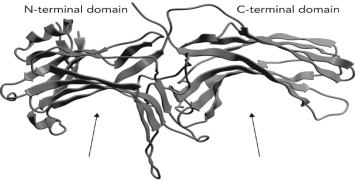
A) " ARK"
B) "GTP-bound G "
C) "dephosphorylated GPCR"
D) "phosphorylated GPCR"

A) " ARK"
B) "GTP-bound G "
C) "dephosphorylated GPCR"
D) "phosphorylated GPCR"

Unlock Deck
Unlock for access to all 102 flashcards in this deck.
Unlock Deck
k this deck
41
Both the silence of death domain and TNF receptor-associated death domain proteins
A) inhibit downstream signaling.
B) activate downstream signaling.
C) are phosphorylated when TNF- is bound to its receptor.
D) bind TNF receptor death domains.
A) inhibit downstream signaling.
B) activate downstream signaling.
C) are phosphorylated when TNF- is bound to its receptor.
D) bind TNF receptor death domains.

Unlock Deck
Unlock for access to all 102 flashcards in this deck.
Unlock Deck
k this deck
42
Consider a mutant cell that does not form DISC on TNF signaling. Which of the following would occur in this mutant cell if exposed to TNF- ?
A) Caspase 3 would be activated.
B) TNF- would bind to the TNF receptor.
C) Caspase 8 would be activated.
D) The cell would undergo apoptosis.
A) Caspase 3 would be activated.
B) TNF- would bind to the TNF receptor.
C) Caspase 8 would be activated.
D) The cell would undergo apoptosis.

Unlock Deck
Unlock for access to all 102 flashcards in this deck.
Unlock Deck
k this deck
43
Which of the following is true of procaspase 8?
A) It is proteolytically active.
B) It can cleave caspase 3.
C) It can be activated by proteolysis.
D) It is a kinase.
A) It is proteolytically active.
B) It can cleave caspase 3.
C) It can be activated by proteolysis.
D) It is a kinase.

Unlock Deck
Unlock for access to all 102 flashcards in this deck.
Unlock Deck
k this deck
44
A caspase is a
A) protease.
B) kinase.
C) phosphatase.
D) transmembrane receptor.
A) protease.
B) kinase.
C) phosphatase.
D) transmembrane receptor.

Unlock Deck
Unlock for access to all 102 flashcards in this deck.
Unlock Deck
k this deck
45
On insulin binding to the insulin receptor, MAP kinase signaling proteins are activated. Which of the following proteins are part of this signaling pathway?
A) Shc
B) IRS
C) PI-3K
D) GLUT-1
A) Shc
B) IRS
C) PI-3K
D) GLUT-1

Unlock Deck
Unlock for access to all 102 flashcards in this deck.
Unlock Deck
k this deck
46
Predict which bond of a target protein would be cleaved by caspase 3 executioner enzyme. 
A) 1
B) 2
C) 3
D) 4

A) 1
B) 2
C) 3
D) 4

Unlock Deck
Unlock for access to all 102 flashcards in this deck.
Unlock Deck
k this deck
47
Caspases contain
A) phosphorylated tyrosines when activated.
B) death domains.
C) an active site cysteine residue.
D) SODD.
A) phosphorylated tyrosines when activated.
B) death domains.
C) an active site cysteine residue.
D) SODD.

Unlock Deck
Unlock for access to all 102 flashcards in this deck.
Unlock Deck
k this deck
48
Which of the following occurs after activation of the PI-3K signaling pathway?
A) Glycogen synthesis rates decrease.
B) GRB2 is activated.
C) GLUT-1 levels decrease.
D) Glucose uptake increases.
A) Glycogen synthesis rates decrease.
B) GRB2 is activated.
C) GLUT-1 levels decrease.
D) Glucose uptake increases.

Unlock Deck
Unlock for access to all 102 flashcards in this deck.
Unlock Deck
k this deck
49
Which protein is part of the TNF receptor-activated programmed cell death signaling pathway?
A) FADD
B) TRAF2
C) NF B-inducing kinase
D) IKK
A) FADD
B) TRAF2
C) NF B-inducing kinase
D) IKK

Unlock Deck
Unlock for access to all 102 flashcards in this deck.
Unlock Deck
k this deck
50
Which of the following is true of active NF B?
A) It is a dimer.
B) It is phosphorylated.
C) It is in a complex with a DD.
D) It has been proteolytically activated.
A) It is a dimer.
B) It is phosphorylated.
C) It is in a complex with a DD.
D) It has been proteolytically activated.

Unlock Deck
Unlock for access to all 102 flashcards in this deck.
Unlock Deck
k this deck
51
Construct a functional pathway out of the following steps. A: Phosphorylation of subunits of the insulin receptor occurs. B: Insulin binds to subunits of the insulin receptor.
C: PI-3K is activated.
D: IRS is phosphorylated.
A) C, A, B, D
B) B, D, A, C
C) B, A, C, D
D) B, A, D, C
C: PI-3K is activated.
D: IRS is phosphorylated.
A) C, A, B, D
B) B, D, A, C
C) B, A, C, D
D) B, A, D, C

Unlock Deck
Unlock for access to all 102 flashcards in this deck.
Unlock Deck
k this deck
52
Consider a mutation in procaspase 3 that changes Asp28 to an amino acid that is no longer a substrate for autocleavage. This mutant would
A) no longer be cleaved by caspase 8.
B) no longer obtain a quaternary structure.
C) be partially activated.
D) be fully activated.
A) no longer be cleaved by caspase 8.
B) no longer obtain a quaternary structure.
C) be partially activated.
D) be fully activated.

Unlock Deck
Unlock for access to all 102 flashcards in this deck.
Unlock Deck
k this deck
53
Which of the following acts as a transcription factor in the cell survival pathway activated by TNF- ?
A) p50:p65 complex
B) NIK:RIP complex
C) I B
D) IKK
A) p50:p65 complex
B) NIK:RIP complex
C) I B
D) IKK

Unlock Deck
Unlock for access to all 102 flashcards in this deck.
Unlock Deck
k this deck
54
A new protein is discovered that contains a pleckstrin homology domain. Which of the following is likely to bind to the protein?
A) PI P3
B) PI-3K
C) phosphorylated tyrosines
D) Ca2+
A) PI P3
B) PI-3K
C) phosphorylated tyrosines
D) Ca2+

Unlock Deck
Unlock for access to all 102 flashcards in this deck.
Unlock Deck
k this deck
55
If a mutation occurred in SODD that prohibited its interaction with the DD of TNF receptor, the TNF receptor would
A) no longer form a trimer.
B) no longer be able to release TNF- .
C) bind TRADD, even in the absence of TNF- .
D) bind NF B, even in the absence of TNF- .
A) no longer form a trimer.
B) no longer be able to release TNF- .
C) bind TRADD, even in the absence of TNF- .
D) bind NF B, even in the absence of TNF- .

Unlock Deck
Unlock for access to all 102 flashcards in this deck.
Unlock Deck
k this deck
56
On binding of an insulin molecule to the insulin receptor, which region of the receptor becomes phosphorylated? 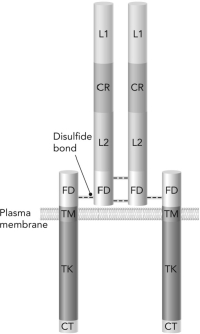
A) CR
B) TM
C) TK
D) L1

A) CR
B) TM
C) TK
D) L1

Unlock Deck
Unlock for access to all 102 flashcards in this deck.
Unlock Deck
k this deck
57
Place the following steps of the apoptotic pathway in their proper order.
A. CASP3 cleavage of cellular proteins
B. Cleavage of procaspase 8
C. Cleavage of procaspase 3
D. Assembly of DD and DED protein complexes
A) D, C, B, A
B) B C, A, D
C) D, B, C, A
D) D, C, A, B
A. CASP3 cleavage of cellular proteins
B. Cleavage of procaspase 8
C. Cleavage of procaspase 3
D. Assembly of DD and DED protein complexes
A) D, C, B, A
B) B C, A, D
C) D, B, C, A
D) D, C, A, B

Unlock Deck
Unlock for access to all 102 flashcards in this deck.
Unlock Deck
k this deck
58
Below shows the cell survival pathway promoted by TNF- . A complex is indicated with a question mark. What is this complex? 
A) inactive NF B
B) active NF B
C) active CASP3
D) NIK

A) inactive NF B
B) active NF B
C) active CASP3
D) NIK

Unlock Deck
Unlock for access to all 102 flashcards in this deck.
Unlock Deck
k this deck
59
Phosphorylation of which of the following is necessary for the increased expression of antiapoptotic genes?
A) RIP
B) TNF receptor
C) FADD
D) IKK
A) RIP
B) TNF receptor
C) FADD
D) IKK

Unlock Deck
Unlock for access to all 102 flashcards in this deck.
Unlock Deck
k this deck
60
Caspase 3 is responsible for
A) activating caspase 8.
B) phosphorylating Fas.
C) degrading key regulatory molecules.
D) dephosphorylating FasL.
A) activating caspase 8.
B) phosphorylating Fas.
C) degrading key regulatory molecules.
D) dephosphorylating FasL.

Unlock Deck
Unlock for access to all 102 flashcards in this deck.
Unlock Deck
k this deck
61
Which of the following is a metabolite receptor?
A) aldosterone receptor
B) glucocorticoid receptor
C) progesterone receptor
D) thyroid hormone receptor
A) aldosterone receptor
B) glucocorticoid receptor
C) progesterone receptor
D) thyroid hormone receptor

Unlock Deck
Unlock for access to all 102 flashcards in this deck.
Unlock Deck
k this deck
62
The ligands for metabolite receptors are often derived from dietary nutrients, including all EXCEPT which of the following?
A) essential amino acids
B) vitamins
C) unsaturated fatty acids
D) saturated fatty acids
A) essential amino acids
B) vitamins
C) unsaturated fatty acids
D) saturated fatty acids

Unlock Deck
Unlock for access to all 102 flashcards in this deck.
Unlock Deck
k this deck
63
Cultures of two different cell types are exposed to the same signaling ligand. Analysis of gene expression shows that only one of the cell types responded to the ligand. Which of the following may account for this difference?
A) The ligand was only bioavailable to one of the cell types.
B) Only one of the cell types contained accessible target gene DNA sequences.
C) Only one cell type contained DNA.
D) The ligand could only pass through the membrane of one of the cell types.
A) The ligand was only bioavailable to one of the cell types.
B) Only one of the cell types contained accessible target gene DNA sequences.
C) Only one cell type contained DNA.
D) The ligand could only pass through the membrane of one of the cell types.

Unlock Deck
Unlock for access to all 102 flashcards in this deck.
Unlock Deck
k this deck
64
Below is shown the structure of a homodimer of the GR DNA-binding domain. Four areas are highlighted. Which is most likely to interact with DNA? 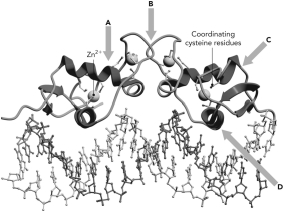
A) A
B) B
C) C
D) D

A) A
B) B
C) C
D) D

Unlock Deck
Unlock for access to all 102 flashcards in this deck.
Unlock Deck
k this deck
65
This Zn2+-containing homodimer is part of 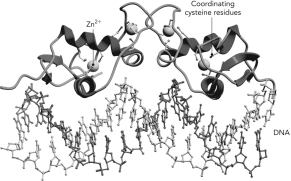
A) the glucocorticoid receptor.
B) PPAR -RXR .
C) TRADD.
D) the retinoic acid receptor.

A) the glucocorticoid receptor.
B) PPAR -RXR .
C) TRADD.
D) the retinoic acid receptor.

Unlock Deck
Unlock for access to all 102 flashcards in this deck.
Unlock Deck
k this deck
66
Hsp90 is a type of
A) chaperonin.
B) kinase.
C) response element.
D) heat sensing protease.
A) chaperonin.
B) kinase.
C) response element.
D) heat sensing protease.

Unlock Deck
Unlock for access to all 102 flashcards in this deck.
Unlock Deck
k this deck
67
Activation of caspases ultimately leads to the programmed death of the cell. What is this process known as? Explain why this may be a beneficial outcome to the organism.

Unlock Deck
Unlock for access to all 102 flashcards in this deck.
Unlock Deck
k this deck
68
A class of proteins that assist other proteins to fold are known as proteins.
A) folding assist
B) proteasome
C) chaperonin
D) overseer
A) folding assist
B) proteasome
C) chaperonin
D) overseer

Unlock Deck
Unlock for access to all 102 flashcards in this deck.
Unlock Deck
k this deck
69
The __________ domain functions as a protein-protein interaction module and is located in the cytoplasmic tail of TNF receptors.
A) death
B) SH2
C) SH3
D) RIP
A) death
B) SH2
C) SH3
D) RIP

Unlock Deck
Unlock for access to all 102 flashcards in this deck.
Unlock Deck
k this deck
70
Cell-specific responses to signaling molecules are possible because
A) nuclear receptor expression is cell specific.
B) target palindromic DNA sequences are ubiquitous.
C) signaling molecules are hydrophobic and can pass through the plasma membrane.
D) only some cells express gated channels for the signaling molecules.
A) nuclear receptor expression is cell specific.
B) target palindromic DNA sequences are ubiquitous.
C) signaling molecules are hydrophobic and can pass through the plasma membrane.
D) only some cells express gated channels for the signaling molecules.

Unlock Deck
Unlock for access to all 102 flashcards in this deck.
Unlock Deck
k this deck
71
Which of the following DNA sequences is MOST likely to be bound by a steroid receptor?
A) AGGAGAACATCATGTTCT
B) AGGAGATAGGAGAACT
C) TTTGATCCAGTTTCCAGT
D) CCCAAGTTCCCAAG
A) AGGAGAACATCATGTTCT
B) AGGAGATAGGAGAACT
C) TTTGATCCAGTTTCCAGT
D) CCCAAGTTCCCAAG

Unlock Deck
Unlock for access to all 102 flashcards in this deck.
Unlock Deck
k this deck
72
Removal of which metal ion would likely alter the structure of the GR DNA-binding domain and preclude it from binding to DNA?
A) Zn2+
B) Mg2+
C) Ca2+
D) Fe2+
A) Zn2+
B) Mg2+
C) Ca2+
D) Fe2+

Unlock Deck
Unlock for access to all 102 flashcards in this deck.
Unlock Deck
k this deck
73
A response element is
A) any protein whose expression is changed in response to a signal.
B) a sequence of regulatory DNA.
C) a domain of the glucocorticoid receptor that binds DNA.
D) a sequence of DNA coding for a steroid or metabolite receptor.
A) any protein whose expression is changed in response to a signal.
B) a sequence of regulatory DNA.
C) a domain of the glucocorticoid receptor that binds DNA.
D) a sequence of DNA coding for a steroid or metabolite receptor.

Unlock Deck
Unlock for access to all 102 flashcards in this deck.
Unlock Deck
k this deck
74
What is the TNF receptor-TRADD-FADD-procaspase 8 adaptor complex also known as?

Unlock Deck
Unlock for access to all 102 flashcards in this deck.
Unlock Deck
k this deck
75
The result of TRADD proteins binding to TNF receptors is that
A) TRADD is phosphorylated.
B) an activated adaptor complex is formed.
C) downstream signaling proteins are inactivated.
D) TNF is degraded.
A) TRADD is phosphorylated.
B) an activated adaptor complex is formed.
C) downstream signaling proteins are inactivated.
D) TNF is degraded.

Unlock Deck
Unlock for access to all 102 flashcards in this deck.
Unlock Deck
k this deck
76
The PPAR -RXR heterodimer interacts with DNA via
A) the LXXLL sequences.
B) leucine zipper motifs.
C) zinc finger motifs.
D) basic leucine zipper motifs.
A) the LXXLL sequences.
B) leucine zipper motifs.
C) zinc finger motifs.
D) basic leucine zipper motifs.

Unlock Deck
Unlock for access to all 102 flashcards in this deck.
Unlock Deck
k this deck
77
Explain how the conformational organization of a nuclear receptor homodimer allows it to recognize inverted repeat sequences of DNA.

Unlock Deck
Unlock for access to all 102 flashcards in this deck.
Unlock Deck
k this deck
78
Which of the following is NOT an expected effect of the binding of the glucocorticoid response element by GR?
A) upregulation of annexin I
B) inhibition of the inflammatory response
C) upregulation of cyclooxygenase-2
D) decreased interaction of p65 and p50 of NF B
A) upregulation of annexin I
B) inhibition of the inflammatory response
C) upregulation of cyclooxygenase-2
D) decreased interaction of p65 and p50 of NF B

Unlock Deck
Unlock for access to all 102 flashcards in this deck.
Unlock Deck
k this deck
79
Differentiate between the caspase in the apoptotic pathway that is activated by autocleavage and the caspase that is activated by another enzyme. Clearly name each caspase.

Unlock Deck
Unlock for access to all 102 flashcards in this deck.
Unlock Deck
k this deck
80
Nuclear receptors are ligand-activated transcription factors that control a wide range of physiologic responses. The responses are governed by cell-specific expression of nuclear receptors and coregulatory proteins and accessibility of target gene DNA sequences. What else governs the responses?

Unlock Deck
Unlock for access to all 102 flashcards in this deck.
Unlock Deck
k this deck



